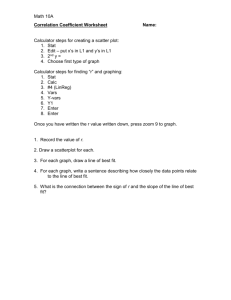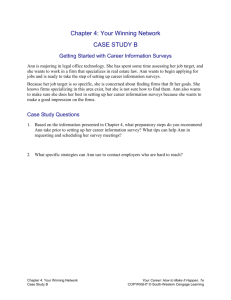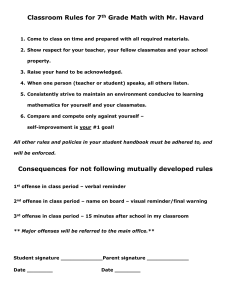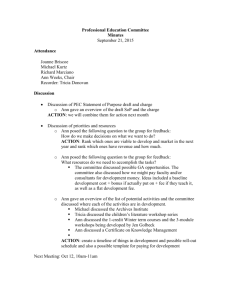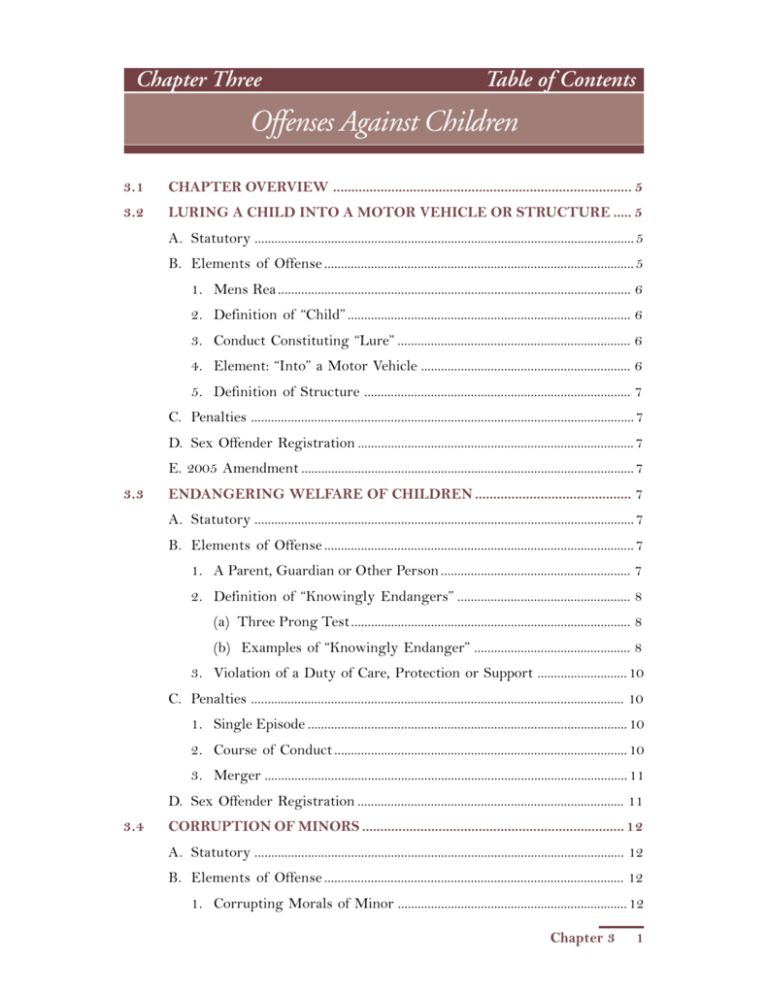
Offenses Against Children
Chapter Three
Table of Contents
Offenses Against Children
3.1
CHAPTER OVERVIEW .................................................................................. 5
3.2
LURING A CHILD INTO A MOTOR VEHICLE OR STRUCTURE ..... 5
A. Statutory .................................................................................................................. 5
B. Elements of Offense ............................................................................................. 5
1. Mens Rea .......................................................................................................... 6
2. Definition of “Child” ..................................................................................... 6
3. Conduct Constituting “Lure” ...................................................................... 6
4. Element: “Into” a Motor Vehicle ............................................................... 6
5. Definition of Structure ................................................................................ 7
C. Penalties ................................................................................................................... 7
D. Sex Offender Registration ................................................................................... 7
E. 2005 Amendment .................................................................................................... 7
3.3
ENDANGERING WELFARE OF CHILDREN ........................................... 7
A. Statutory .................................................................................................................. 7
B. Elements of Offense ............................................................................................. 7
1. A Parent, Guardian or Other Person ......................................................... 7
2. Definition of “Knowingly Endangers” .................................................... 8
(a) Three Prong Test .................................................................................... 8
(b) Examples of “Knowingly Endanger” ............................................... 8
3. Violation of a Duty of Care, Protection or Support ........................... 10
C. Penalties ................................................................................................................ 10
1. Single Episode ................................................................................................ 10
2. Course of Conduct ........................................................................................ 10
3. Merger ............................................................................................................. 11
D. Sex Offender Registration ................................................................................ 11
3.4
CORRUPTION OF MINORS ........................................................................ 12
A. Statutory ............................................................................................................... 12
B. Elements of Offense .......................................................................................... 12
1. Corrupting Morals of Minor ..................................................................... 12
Chapter 3
1
Offenses Against Children
C. Adjudication of Delinquency Unnecessary ................................................... 13
D. Presumptions Regarding Minor’s Age and Court Orders ......................... 13
E. Mistakes as to Age ............................................................................................... 13
F. Penalties ................................................................................................................. 14
G. Sex Offender Registration ................................................................................. 14
3.5
SEXUAL ABUSE OF CHILDREN ............................................................... 14
A. Statutory ............................................................................................................... 14
B. Purpose of Statute ............................................................................................. 14
1. Elements in General .................................................................................... 15
2. Photograph, Videotape or Depiction ...................................................... 17
(a) Specific Elements .................................................................................. 17
(b) Penalty ..................................................................................................... 17
3. Dissemination ............................................................................................... 17
(a) Specific Elements .................................................................................. 17
(b) Penalty ..................................................................................................... 17
4. Possession ........................................................................................................ 17
(a) Specific Elements .................................................................................. 17
(b) Penalty ..................................................................................................... 18
D. Evidence of Age ................................................................................................. 18
1. Mistake as to Age ......................................................................................... 18
2. Exceptions ..................................................................................................... 18
E. Sex Offender Registration ................................................................................ 18
F. Merger ................................................................................................................... 18
3.6.
UNLAWFUL CONTACT WITH MINOR .................................................. 19
A. Statutory ............................................................................................................... 19
B. Elements of Offense .......................................................................................... 19
C. Penalties ................................................................................................................ 20
1. Grading ........................................................................................................... 20
2. No Merger ...................................................................................................... 20
D. Concurrent Jurisdiction to Prosecute ............................................................. 20
E. Definitions ............................................................................................................ 20
F. Sex Offender Registration ................................................................................ 21
2
Chapter 3
Offenses Against Children
3.7
SEXUAL EXPLOITATION OF CHILDREN ............................................. 21
A. Statutory ............................................................................................................... 21
B. Elements of Offense .......................................................................................... 21
1. Offense Defined ............................................................................................. 21
2. Definitions ...................................................................................................... 21
C. Penalties ................................................................................................................ 21
D. Sex Offender Registration ................................................................................ 21
3.8
INTERNET CHILD PORNOGRAPHY ...................................................... 22
A. Act Declared Unconstitutional ........................................................................ 22
3.9
SOLICITATION .............................................................................................. 22
A. Statutory ............................................................................................................... 22
B. Definition of Solicitation and Renunciation ............................................... 22
C. Penalties ................................................................................................................ 23
1. Grading ............................................................................................................ 23
2. Mitigation ....................................................................................................... 23
D. Sex Offender Registration ................................................................................ 23
E. Pertinent Case Law ............................................................................................ 23
1. Culpability of the One Solicited ................................................................ 23
2. Complicity of the One Solicited ................................................................ 23
3. Culpability for Crimes Intended to be Committed ................................ 24
Chapter 3
3
Offenses Against Children
4
Chapter 3
Offenses Against Children
Chapter Three
Offenses Against Children
3.1
CHAPTER OVERVIEW
This chapter outlines statutes specifically designed to protect children. Offenses of
sexual violence which may involve children as victims, such as Rape, 18
PA.CONS.STAT.ANN. § 3121, Statutory Sexual Assault, 18 PA.CONS.STAT.ANN. § 3122,
and Involuntary Deviate Sexual Intercourse, 18 PA.CONS.STAT.ANN. § 3123, are
covered in Chapter 2.
Listed below are the statutes discussed in this chapter.
Section 3.2:
Luring a Child into a Motor Vehicle, 18 PA.CONS.STAT.ANN. § 2910;
Section 3.3:
Endangering Welfare of Children, 18 PA.CONS.STAT.ANN. § 4304;
Section 3.4:
Corruption of Minors, 18 PA.CONS.STAT.ANN. § 6301;
Section 3.5:
Sexual Abuse of Children, 18 PA.CONS.STAT.ANN. § 6312;
Section 3.6:
Unlawful Contact with Minor, 18 PA.CONS.STAT.ANN. § 6318;
Section 3.7:
Sexual Exploitation of Children, 18 PA.CONS.STAT.ANN. § 6320; and
Section 3.8:
Internet Child Pornography, 18 PA.CONS.STAT.ANN. §§ 7621-7630.
Lastly, Section 3.9 examines the cases where children are the intended victims of
solicitation crimes involving sexual violence.
3.2 LURING A CHILD INTO A MOTOR VEHICLE OR STRUCTURE
A. Statutory
18 Pa.Cons.Stat.Ann. § 2910
B. Elements of Offense
1) Lures or attempts to lure a child;
2) Into a motor vehicle; or
3) Into a structure;
Chapter 3
5
Offenses Against Children
4) Unless the circumstances reasonably indicate that the child is in need of
assistance;
5) Without the consent, express or implied, of the child’s parent or guardian.
1. Mens Rea
As to the luring element, culpability required is intentionally, knowingly or
recklessly. Commonwealth v. Figueroa, 648 A.2d 555 (Pa. Super. 1994),
appeal denied, 540 Pa. 578, 655 A.2d 510 (1995); Commonwealth v.
Gallagher, 2005 Pa. Super. 116 (2005).
As to the “child” element, the Commonwealth must prove that the
defendant intentionally sought out the victim because the victim was under
the age of 18, knew the victim was under the age 18 or was reckless as to
the age of the victim. Commonwealth v. Gallagher.
There is strict liability in the luring statute only with respect to an intent to
harm. Luring does not require a bad purpose intent. Commonwealth v.
Figueroa; Commonwealth v. Gallagher.
2. Definition of “child”
A person under 18 years of age. 18 PA.CONS.STAT.ANN. § 2908(b)
3. Conduct Constituting “lure”
Hand motions – waiving or motioning “come here” to the victim.
Commonwealth v. McClintock, 639 A.2d 1222, 1227 (Pa. Super. 1994).
Inducement - offering the victim money in exchange for work, the nature
of which defendant refused to describe unless the victim accompanied him
to his car, constitutes a “lure”. The definition of “lure” includes tempting
by pleasure or gain, and the gain does not have to be a pleasant one; it can
be “any kind of inducement.” Commonwealth v. Adamo, 637 A.2d 302,
307 (Pa. Super. 1994).
Commands and Threats - the term “lure” is not limited to enticement or
invitation to pleasure or gain. Commonwealth v. Nanorta, 742 A.2d 176
(Pa. Super. 1999). The court held that the command, “get in my car” could
be characterized as a lure.
4. Element: “Into” a Motor Vehicle
There is a requirement that the child is lured “into” a vehicle. The plain
meaning of Luring a Child into a Motor Vehicle does not include the
inchoate offense of attempting to lure a child into a motor vehicle. Where
a defendant does not manage to get the child into the vehicle, the
appropriate offense is criminal attempt. Commonwealth v. Tate, 572 Pa.
411, 816 A.2d 1097 (2003).
“Motor vehicle” defined: Every self-propelled device in, upon or by which
any person or property is or may be transported or drawn on a public
highway. 18 PA.CONS.STAT.ANN. § 2910(C).
6
Chapter 3
Offenses Against Children
5. Definition of Structure
“Structure” defined: A house, apartment building, shop, warehouse, barn,
building, vessel, railroad car, cargo container, house car, trailer, trailer coach,
camper, mine, floating home or other enclosed structure capable of holding
a child, which is not open to the general public. 18 PA.CONS.STAT.ANN. §
2910(C).
Affirmative defense: it’s an affirmative defense that the person lured or
attempted to lure the child into the structure for a lawful purpose. 18
PA.CONS.STAT.ANN. § 2910(b).
C. Penalties
Luring a Child into a Motor Vehicle or Structure is a Misdemeanor of the First
Degree. In accordance with 18 PA. CONS. STAT. ANN. § 1104, in the case of a
misdemeanor of the first degree, a term of imprisonment shall be fixed by the
court at no more than 5 years, and in accordance with 18 PA. CONS. STAT. ANN. §
1101, a fine not to exceed $ 10,000.00.
D. Sex Offender Registration
The crime of Luring a Child into a Motor Vehicle under 18 PA.CONS.STAT.ANN.
§ 2910 was added in 2004 as a “listed offense” under the Pennsylvania
Registration of Sexual Offenders Act (Megan’s Law II). See 42
PA.CONS.STAT.ANN. § 9795.1(a).
E. 2005 Amendment
On November 10, 2005, Luring a Child into a Motor Vehicle was amended to
Luring a Child into a Motor Vehicle or Structure. The new statute makes it a
crime to lure a child into a structure, provides an affirmative defense to luring a
child to a structure for a lawful purpose, and defines motor vehicle and
structure. The act took effect 60 days following November 10, 2005.
3.3 ENDANGERING WELFARE OF CHILDREN
A. Statutory
18 Pa.Cons.Stat.Ann. § 4304.
B. Elements of Offense
1) A parent, guardian, or other person supervising the welfare of a child
under 18 years of age;
2) Knowingly endangers the welfare of the child;
3) By violating a duty of care, protection or support.
1. A Parent, Guardian, or Other Person
The duty to care, protect or support a child is not limited to natural and
adoptive parents. “Whenever a person is placed in control and supervision
Chapter 3
7
Offenses Against Children
of a child, that person has assumed such a status relationship to the child so
as to impose a duty to act.” Commonwealth v. Kellam, 719 A.2d 792, 796
(Pa. Super. 1998). (Where the defendant lived with his girlfriend and her
infant daughter, controlled many aspects of the mother’s life, including
raising her other children and the infant victim, voluntarily assumed
parental responsibilities with regard to the child, (e.g. watching her when
the mother was away, changing her diaper and feeding her), he was held to
have supervised the welfare of the child.)
There must be a case-by-case review in determining whether an adult living
with a minor child is criminally liable and there must be evidence that the
adult was “involved” with the child. Factors such as playing with the child,
eating with the child, babysitting the child or otherwise interacting with
the child should be examined. Commonwealth v. Brown, 721 A.2d 1105,
1108 (Pa. Super. 1998).
Defendant had a duty to protect the child when she accepted the role
of babysitter. Commonwealth v. Vining, 744 A.2d 310 (Pa. Super.
1999), appeal denied, 564 Pa. 709, 764 A.2d 1069 (2000).
Where there is no evidence of defendant’s role as a supervisor or
guardian of the child, (e.g. defendant is just a visitor in the victim’s
home) defendant cannot be convicted of Endangering Welfare of
Children. Commonwealth v. Halye, 719 A.2d. 763 (Pa. Super. 1998),
appeal denied, 560 Pa. 699, 743 A.2d 916 (1999), cert. denied, 529 U.S.
1012, 120 S. Ct. 1287, 146 L. Ed. 2d 233 (2000).
2. Definition of “Knowingly Endangers”
(a)
Three Prong Test
The accused must act “knowingly” to be convicted of endangering
the welfare of a child. The Superior Court of Pennsylvania has
employed a three-prong standard to determine whether the
Commonwealth’s evidence is sufficient to prove this intent element:
(b)
i)
The accused is aware of his duty to protect the child;
ii)
The accused is aware the child is in circumstances that
threaten the child’s physical or psychological welfare; and
iii)
The accused failed to act or has taken action so lame or
meager that such actions cannot reasonably be expected to
protect the child’s welfare.
Examples of “Knowingly Endanger”
In Commonwealth v. Miller, 600 A.2d 988 (Pa. Super. 1992), the
Court held that defendant was not aware that she had placed her
child in circumstances that threatened the child’s physical or
psychological welfare where the defendant agreed to go out only
after being told by the child’s father that his neighbor had
8
Chapter 3
Offenses Against Children
agreed to baby sit the child. Defendant relied on that
representation and child had been beaten and burned. The court
held that the nature of her injuries would have been apparent to
defendant Jones and thus he knew the victim had been injured
and needed medical assistance, but failed to seek immediate
medical attention for the child.
In Commonwealth v. Retkofsky, 860 A.2d 1098 (Pa. Super.
2004), the Court held that defendant was aware of the dangers
and “knowingly” endangered his son when he drove an ATV at
an accelerated speed down a paved residential street, fleeing from
police, with his nine year-old son hanging onto defendant’s body
without any other restraint.
Commonwealth v. Cardwell, 515 A.2d 311 (Pa. Super. 1986),
appeal denied, 515 Pa. 573, 527 A.2d 535 (1987): The statute
requires affirmative performance which cannot be met simply by
showing any step at all toward preventing harm, however
incomplete or ineffectual. The person charged with the duty of
care must take steps that are reasonably calculated to achieve
success. The facts of the Cardwell case involved a situation
where the defendant’s husband had sexually abused her daughter
for a period of four years and defendant, upon learning of the
abuse, did nothing other than to write two angry letters to her
husband and failed to take concrete steps to remove her daughter
from the situation, defendant was guilty of Endangering
Welfare of Children.
Where a child suffers from a serious and life-threatening medical
condition, prayers and anointment of the child are not sufficient
steps to protect the child’s welfare. Parents have an affirmative
duty to provide medical care to protect the child’s life, regardless
or despite their religious beliefs. Commonwealth v. Barnhart,
497 A.2d 616 (Pa. Super. 1985), appeal denied, 517 Pa. 620, 538
A.2d 874 (1988), cert. denied, 488 U.S. 817, 109 S. Ct. 55, 102 L.
Ed. 34 (1988). See also Commonwealth v. Foster, 764 A.2d 1076
(Pa. Super. 2000), appeal denied, 566 Pa. 658, 782 A.2d 542 (2001).
Where defendant did nothing to better the conditions of his
house (dirty house with foul odor, dried food and food stains
covering the walls, flies, maggots, hundreds of mice, spoiled food
in the refrigerator, a hole in the roof, large holes in the kitchen
floor and ceiling which allowed water to flow into an electric box
in the basement), the defendant was guilty of Endangering
Welfare of Children. Commonwealth v. Wallace, 817 A.2d 485
(Pa. Super. 2002), appeal denied, 574 Pa. 774, 833 A.2d 143 (2003),
cert. denied, 541 U.S. 907, 124 S. Ct. 1610, 158 L. Ed.2d 251
(2004).
Chapter 3
9
Offenses Against Children
The statute does not require actual infliction of physical injury
or that child be in imminent threat of physical harm; exposure
to danger is sufficient. Commonwealth v. Wallace, 817 A.2d
485, 491 (Pa. Super. 2002), appeal denied, 574 Pa. 774, 833 A.2d
143 (2003), cert. denied, 541 U.S. 907, 124 S. Ct. 1610, 158 L.
Ed.2d 251 (2004). Even though his children suffered no physical
harm, by allowing the children to live “with such filth and
vermin, with no working furnace for heat, and with water
running into the electrical box creating a fire hazard”, the risk of
physical and/or psychological harm was present. 817 A.2d at
492.
3. Violation of a Duty of Care, Protection or Support.
Parents have an affirmative legal duty to protect their child and seek
medical help when the life of their child is threatened despite their religious
beliefs. The child’s welfare should override the parents’ religious beliefs and
failure to seek medical care for the child under such circumstances
constitutes a breach of their duties as parents. Every parent has a duty of
care for their child and at the very least “to avert the child’s untimely
death.” Commonwealth v. Barnhart, 497 A.2d 616, 619 (Pa. Super. 1985),
appeal denied, 517 Pa. 620, 538 A.2d 874 (1988), cert. denied, 488 U.S. 817,
109 S. Ct. 55, 102 L. Ed. 34 (1988).
It is not a violation of the parents’ duty of care when their minor daughter
is sexually active, even if they have knowledge of it. Where there is no
evidence that the parents “permitted, condoned, fostered or prompted” their
thirteen year old daughter’s sexual activity with her boyfriend, which led to
her pregnancy, the parents are not guilty of endangering the welfare of
their child. Commonwealth v. Campbell, 580 A.2d 868, 869 (Pa. Super.
1990).
C. Penalties
1. Single Episode
Endangering the Welfare of Children is a Misdemeanor of the First
Degree. In accordance with 18 PA. CONS. STAT. ANN. § 1104, in the case of a
misdemeanor of the first degree, a term of imprisonment shall be fixed by
the court at nor more than 5 years, and in accordance with 18 PA. CONS.
STAT. ANN. § 1101, a fine not to exceed $ 10,000.00.
2. Course of Conduct
Where there is a course of conduct of endangering the welfare of a child,
the offense constitutes a felony of the third degree. In accordance with 18
PA. CONS. STAT. ANN. § 1103, in the case of a felony of the third, a term of
imprisonment shall be fixed by the court at nor more than 7 years, and in
accordance with 18 PA. CONS. STAT. ANN. § 1101, a fine not to exceed $
15,000.00.
10
Chapter 3
Offenses Against Children
Examples of “Course of Conduct”
Where defendant’s two young children had dirty hands, feet and
toes, dirt all over their skin, dirty clothes, numerous bruises on their
buttocks groin, thighs and backs, consistent with intentional
infliction, and one of the victims had lost twenty percent of her
body weight in a two week period, and defendant admits she was the
full-time caregiver, jury could reasonably conclude course of conduct
existed that endangered the welfare of the children.
Commonwealth v. Mackert, 781 A.2d 178 (Pa. Super. 2001), appeal
denied, 568 Pa. 696, 796 A.2d 980 (2002).
Course of conduct existed where the sexual abuse of his
stepdaughter occurred over a period of two years. Commonwealth
v. Ressler, 798 A.2d 221 (Pa. Super. 2002).
Where the entire episode for which defendant was charged, was one
event, on one night, there was no “course of conduct” justifying a
third degree felony charge of Endangering Welfare of Children.
The legislative intent of 18 Pa.Cons.Stat.Ann. § 4304(b) is to punish
a parent who abused their child over a period of time and for
repeated behavior, but not for a single incident that occurred within
minutes. Commonwealth v. Popow, 844 A.2d 13 (Pa. Super. 2004).
Where the Commonwealth labels the charge of Endangering
Welfare of Children in the information as a felony of the third
degree, but the descriptive language in the information indicates
only a misdemeanor and no course of conduct is alleged, the trial
court was correct in sentencing defendant to a misdemeanor
sentence upon a conviction for Endangering Welfare of Children.
Commonwealth v. Passarelli, 789 A.2d 708 (Pa. Super. 2001), appeal
granted in part, 571 Pa. 592, 812A.2d 1225 (2002), affirmed, 573 Pa.
372, 825 A.2d 628 (2003).
3. Merger
Endangering Welfare of Children is not a lesser included offense of
Reckless Endangerment. Commonwealth v. Martir, 712 A.2d 327 (Pa. Super.
1998). However, Endangering Welfare of Children is a lesser included
offense of Involuntary Manslaughter if the same facts are used as a basis
for both convictions. Commonwealth v. Barnhart, 497 A.2d 616, 619, 630
(Pa. Super. 1985), appeal denied, 517 Pa. 620, 538 A.2d 874 (1988), cert.
denied, 488 U.S. 817, 109 S. Ct. 55, 102 L. Ed. 34 (1988). In
Commonwealth v. Bird, 597 A.2d 1169 (Pa. Super. 1991), the court held that
the trial court erred in not merging the two offenses since the same facts
were relevant to prove both. .
D. Sex Offender Registration
The crime of Endangering Welfare of Children under 18 PA.CONS.STAT.ANN. §
4304 is not specifically designated as a “listed offense” under the Pennsylvania
Chapter 3 11
Offenses Against Children
Registration of Sex Offenders Act (Megan’s Law II). See 42
Pa.Cons.Stat.Ann.§ 9795.1.
3.4 CORRUPTION OF MINORS
A. Statutory
18 PA.CONS.STAT.ANN. § 6301(a)(1)& (2).
B. Elements of Offense
1) Any person
a) Being of the age of 18 years and upwards,
b) By any act corrupts or tends to corrupt the morals of any minor less
than 18 years of age, or
c) Aids, abets, entices or encourages any such minor in the commission
of any crime, or
d) Knowingly assists or encourages such minor in violating his or her
parole or any order of court; or
2) Any person
a) Who knowingly aids, abets, entices or encourages
b) A minor younger than 18 years of age
c) To commit truancy.
1. Corrupting Morals of Minor
Standard in deciding what conduct can be said to corrupt the morals of a
minor is “the common sense of the community, as well as the sense of
decency, propriety and the morality which most people entertain.”
Commonwealth v. Pankraz, 554 A. 2d 974, 977 (Pa. Super. 1989), appeal
denied, 522 Pa. 618, 563 A.2d 887 (1989), quoting Commonwealth v.
Randall, 133 A.2d 276 (Pa. Super. 1957), cert denied, 355 U.S. 954 (1958);
Commonwealth v. Decker, 698 A.2d 99, 101(Pa. Super. 1997), appeal
denied, 550 Pa. 698, 705 A.2d 1304 (1998). Since the statute is protective in
nature and designed to “cover a broad range of conduct in order to
safeguard the welfare and security of our children”, the statute must be
drawn broadly. Commonwealth v. Barnette, 760 A. 2d 1166, 1173(Pa.
Super. 2000), appeal denied, 566 Pa. 634, 781 A.2d 138 (2001).
There is no need to prove that the minor’s morals were actually corrupted.
The Commonwealth need only prove that the conduct of the defendant
tended to corrupt the minor’s morals. Commonwealth v. Barnette, 760
A.2d 1166 (Pa. Super. 2000) appeal denied, 566 Pa. 634, 781 A.2d 138
(2001)(Defendant was guilty of Corruption of Minors where he requested a
16 year old youth to sign for a package containing marijuana even though
12
Chapter 3
Offenses Against Children
he told the youth it contained “knick knacks”); Commonwealth v.
Mumma, 489 Pa. 547, 414 A.2d 1026 (Pa. 1980).
Underlying criminal activity is not required. Statute states that conduct
which corrupts or tends to corrupt is by “any act” not by any “criminal act.”
Commonwealth v. Decker, 698 A.2d 99 (Pa. Super. 1997) appeal denied, 550
Pa. 698, 705 A.2d 1304 (1998). (Defendant, a 37 year old male, guilty of
Corruption of Minors where he engaged in consensual sexual intercourse
with a 15 year old female.).
Sexual intercourse with a minor is considered corruption of morals.
Commonwealth v. Berry, 513 A. 2d 410 (Pa. Super. 1986).
Conviction for corruption of minors charge can still stand where there are
acquittals of other offenses which were specified in the information filed
against the defendant as the corrupting acts. Commonwealth v. Bricker,
580 A.2d 388 (Pa. Super. 1990), appeal denied, 527 Pa. 596, 589 A.2d 687
(1991), Commonwealth v. Miller, 657 A. 2d 946 (Pa. Super. 1995).
(Defendants’ convictions for COM in both cases stand even though both
were acquitted of Indecent Assault charges. The courts held that the jury
had the prerogative to convict defendants on the corruption of minors
charge while at the same time acquitting them on the charge of indecent
assault and that inconsistent verdicts will stand as long as there is sufficient
evidence to sustain the conviction.)
A married minor’s morals can be corrupted by his or her spouse.
Commonwealth v. Stafford, 749 A.2d 489, 499-500 (Pa. Super. 2000),
appeal denied, 568 Pa. 660, 795 A.2d 975 (2000).
Consent is not an element in a corruption of minors charge.
Commonwealth v. Kitchen, 814 A.2d 209 (Pa. Super. 2002), affirmed, 576
Pa. 229, 839 A.2d 184 (2003).
C. Adjudication of Delinquency Unnecessary
A conviction under the provisions of this section may be had whether or not
the jurisdiction of any juvenile court has attached or shall thereafter attach to
such minor or whether or not such minor has been adjudicated a delinquent or
shall thereafter be adjudicated a delinquent. 18 PA.CONS.STAT.ANN. § 6301(b).
D. Presumptions Regarding Minor’s Age and Court Orders
In trials and hearings upon charges of violating the provisions of this section,
knowledge of the minor’s age and the court’s orders and decrees concerning
such minor shall be presumed in the absence of proof to the contrary. 18
PA.CONS.STAT.ANN. § 6301(c).
E. Mistakes as to Age
Whenever in this section the criminality of conduct depends upon the
corruption of a minor whose actual age is under 16 years, it is no defense that
the actor did not know the age of the minor or reasonably believed the minor
to be older than 18 years. 18 PA.CONS.STAT.ANN. § 6301(d).
Chapter 3 13
Offenses Against Children
Whenever in this section the criminality of conduct depends upon the
corruption of a minor whose actual age is 16 years or more but less than 18
years, it is a defense for the actor to prove by a preponderance of the evidence
that he reasonably believed the minor to be 18 years or older. 18
PA.CONS.STAT.ANN. § 6301(d).
F. Penalties
Corruption of Minors, under section (a)(1), is a Misdemeanor of the First
Degree. In accordance with 18 PA. CONS. STAT. ANN. § 1104, in the case of a
misdemeanor of the first degree, a term of imprisonment shall be fixed by the
court at nor more than 5 years, and in accordance with 18 PA. CONS. STAT. ANN.
§ 1101, a fine not to exceed $ 10,000.00.
A violation of 18 Pa.Cons.Stat.Ann. § 6301(2), regarding truancy, is a summary
offense. In accordance with 18 PA. CONS. STAT. ANN. § 1105, in the case of a
summary conviction, a term of imprisonment shall be fixed by the court at nor
more than 90 days, and in accordance with 18 PA. CONS. STAT. ANN. § 1101, a
fine not to exceed $ 300. A second offense within one year of the date of the
first conviction is a misdemeanor of the third degree.
G. Sex Offender Registration
The crime of Corruption of Minors under 18 Pa.Cons.Stat.Ann. § 6301 is not
specifically designated as a “listed offense” under the Pennsylvania Registration
of Sex Offenders Act (Megan’s Law). See 42 PA.CONS.STAT.ANN. § 9795.1.
3.5 SEXUAL ABUSE OF CHILDREN
A. Statutory
18 PA.CONS.STAT.ANN. § 6312.
B. Purpose of Statute
The purpose of this statute, prohibiting “sexual abuse of children”, is to
criminalize the filming, depiction or possession of photographs or computer
depictions of children engaging in sexual acts.
On two occasions the Pennsylvania Superior Court has held that the statute is
not unconstitutionally overbroad or vague. Commonwealth v. Pepe, 897 A.2d
463 (Pa.Super. 2006);1 Commonwealth v. Davidson, 860 A.2d 575 (Pa.Super.
2004), appeal granted in part, 582 Pa. 356, 871 A.2d 185 (2005).2
1
2
In Pepe and Davidson, the Superior Court made it clear that the statute proscribes the photographing
or videotaping of “real” children, not computer-generated images. Pepe, 897 A.2d at 464, Davidson, 860
A.2d at 584.
As indicated, the Pennsylvania Supreme Court accepted review of Davidson in 582 Pa. 356, 871 A.2d 185
(2005) , and ordered the parties to address the following issues:
1) Whether 18 PA.CONS.STAT.ANN. § 6312(d) is unconstitutionally vague and overbroad?
14
Chapter 3
Offenses Against Children
C. Elements of Offense
1. Elements in General
The statute reads as follows:
18 PA.CONS.STAT.ANN. § 6312.
Sexual Abuse of Children
(a) Definition. As used in this section, “prohibited sexual
act” means sexual intercourse as defined in section 3101
(relating to definitions), masturbation, sadism, masochism,
bestiality, fellatio, cunnilingus, lewd exhibition of the genitals or nudity if such nudity is depicted for the purpose of
sexual stimulation or gratification of any person who might
view such depiction.
(b) Photographing, videotaping, depicting on
computer or filming sexual acts. Any person who
causes or knowingly permits a child under the age of
18 years to engage in a prohibited sexual act or in the
simulation of such act is guilty of a felony of the second
degree if such person knows, has reason to know or
intends that such act may be photographed, videotaped,
depicted on computer or filmed. Any person who
knowingly photographs, videotapes, depicts on
computer or films a child under the age of 18 years
engaging in a prohibited sexual act or in the simulation
of such an act is guilty of a felony of the second degree.
(c) Dissemination of photographs, videotapes,
computer depictions and films.
(1) Any person who knowingly sells, distributes,
delivers, disseminates, transfers, displays or exhibits
to others, or who possesses for the purpose of sale,
distribution, delivery, dissemination, transfer, display
or exhibition to others, any book, magazine,
pamphlet, slide, photograph, film, videotape,
computer depiction or other material depicting a
child under the age of 18 years engaging in a
prohibited sexual act or in the simulation of such
act commits an offense.
(2) A first offense under this subsection is a felony
of the third degree, and a second or subsequent
2) Did the General Assembly intend that a person charged under 18 PA.CONS.STAT.ANN. § 6312(d) be
subjected to individual counts for each piece of child pornography possessed?
3) If the General Assembly so intended, is it constitutional to impose separate punishments for each
conviction?
Chapter 3
15
Offenses Against Children
offense under this subsection is a felony of the second
degree.
(d) Possession of child pornography.
(1) Any person who knowingly possesses or controls
any book, magazine, pamphlet, slide, photograph,
film, videotape, computer depiction or other material
depicting a child under the age of 18 years engaging
in a prohibited sexual act or in the simulation of
such act commits an offense.
(2) A first offense under this subsection is a felony
of the third degree, and a second or subsequent
offense under this subsection is a felony of the second
degree.
(e) Evidence of age. In the event a person involved in
a prohibited sexual act is alleged to be a child under the
age of 18 years, competent expert testimony shall be
sufficient to establish the age of said person.
(e.1) Mistake as to age. Under subsection (b) only, it is
no defense that the defendant did not know the age of
the child. Neither a misrepresentation of age by the
child nor a bona fide belief that the person is over the
specified age shall be a defense.
(f) Exceptions. This section does not apply to any
material that is possessed, controlled, brought or caused
to be brought into this Commonwealth, or presented
for a bona fide educational, scientific, governmental or
judicial purpose.
“Sexual Intercourse” is defined in 18 PA.CONS.STAT.ANN. § 3101 to include,
in addition to its ordinary meaning, intercourse per os or per anus with
some penetration, however slight; emission is not required.
“Transfer” as used in § 6312(c) herein means a change of possession from
one person to another. Commonwealth v. McCue, 487 A.2d 880, 883
(Pa.Super. 1983).
Consent: The consent of a child victimized by having pornographic
pictures taken of him or her is not a defense. Commonwealth v. Kitchen,
814 A.2d 209, 213 (Pa. Super. 2002), affirmed, 576 Pa. 229, 839 A.2d 184
(2003)(Defendant’s conviction for taking and possessing pornographic
photographs of his 16 year old paramour, with whom he had a child, stands
regardless of the victim’s consent or cohabitation with the defendant.)
16
Chapter 3
Offenses Against Children
2. Photograph, Videotape or Depiction
(a)
Specific Elements: Photographing, videotaping, depicting on
computer or filming sexual acts - 18 PA.CONS.STAT.ANN. § 6312(b)
i) causes or knowingly permits a child under the age of 18 years to
engage in a prohibited sexual act or in the simulation of such
act, and
ii) knows, has reason to know or intends that such act may be
photographed, videotaped, depicted on computer or filmed
(b)
Penalty – A violation of this subsection is a felony of the second
degree.
3. Dissemination
(a)
Specific Elements: Dissemination of photographs, videotapes,
computer depictions and films - 18 PA.CONS.STAT.ANN. §6312(c)
i) knowingly sells, distributes, delivers, disseminates, transfers,
displays or exhibits to others, or who possesses for the purpose of
sale, distribution, delivery, dissemination, transfer, display or
exhibition to others, any book, magazine, pamphlet, slide,
photograph, film, videotape, computerdepiction or other
material,
ii) depicting a child under the age of 18 years engaging in a
prohibited sexual act or in the simulation of such act
(b)
Penalty - A first offense under this subsection is a felony of the third
degree, and a second or subsequent offense under this subsection is a
felony of the second degree.
4. Possession
(a)
Specific Elements: Possession of child pornography - 18
PA.CONS.STAT.ANN. § 6312(d)
i) knowingly possesses3 or controls any book, magazine, pamphlet,
slide, photograph, film, videotape, computer depiction or other
material
ii) depicting a child under the age of 18 years engaging in a
prohibited sexual act or in the simulation of such act commits an
offense.
3
In Commonwealth v. Diodoro, 2006 WL 3095476 (Pa.Super., Nov. 2, 2006), a panel of the Superior Court
held that in relation to crime of Possession of Child Pornography, 18 PA.CONS.STAT.ANN. § 6312(d),
merely viewing child pornography on internet without intentionally (i.e., “knowingly”) saving or
downloading any of the images does not constitute “knowing possession” of child pornography, and
is not a violation of § 6312(d). However, the panel decision was withdrawn and reconsideration was
granted on January 10, 2007. Commonwealth v. Diodoro, 2007 Pa. Super. LEXIS 323 (Pa.Super., January
10, 2007).
Chapter 3
17
Offenses Against Children
(b)
Penalty - A first offense under this subsection is a felony of the third
degree, and a second or subsequent offense under this subsection is a
felony of the second degree.
D. Evidence of Age - 18 PA.CONST.STAT.ANN. §6312(e)
In the event a person involved in a prohibited sexual act is alleged to be a child
under the age of 18 years, competent expert testimony shall be sufficient to
establish the age of said person.
Proof of age, like proof of any other material fact, can be accomplished by the
use of either direct or circumstantial evidence, or both. The trier of fact can
assess the age of the child depicted based on everyday observations and
common experiences with the requisite degree of certainty to satisfy the
standard of proof beyond a reasonable doubt. Commonwealth v. RobertsonDewar, 829 A.2d 1207 (Pa. Super 2003), appeal denied, 576 Pa. 712, 839 A.2d
352 (2003).
Expert testimony: § 6312(e) does not mandate expert opinion testimony to
satisfy the element of age but merely allows that if competent expert
testimony is presented, it shall be sufficient to establish the age element.
Whether expert testimony is necessary must be determined on a case-by-case
basis. Id., at 1212.
1. Mistake as to Age – 18 PA.CONS.STAT.ANN. § 6312 (e.1).
Under subsection (b) only, it is no defense that the defendant did not know
the age of the child. Neither a misrepresentation of age by the child nor a
bona fide belief that the person is over the specified age shall be a defense.
2. Exceptions - 18 PA.CONS.STAT.ANN. § 6312(f).
This section does not apply to any material that is possessed, controlled,
brought or caused to be brought into this Commonwealth, or presented for
a bona fide educational, scientific, governmental or judicial purpose.
E. Sex Offender Registration
The crime of Sexual Abuse of Children under 18 PA.CONS.STAT.ANN.§ 6312 is
designated as a “listed offense” under Pennsylvania Registration of Sexual
Offenders Act (Megan’s Law). See 42 PA.CONS.STAT.ANN. § 9795.1.
F. Merger
Taking photographs in violation of § 6312(b) and possessing the same
photographs in violation of § 6312(d) do not merge for sentencing purposes.
Commonwealth v. Kitchen, 814 A.2d 209, 215 (Pa. Super. 2002), affirmed, 576
Pa. 229, 839 A.2d 184 (2003).
In Commonwealth v. Koehler, 914 A.2d 427 (Pa.Super. 2006), the Superior
Court held that the imposition of 14 separate sentences for each conviction for
sexual abuse of children/possession of child pornography did not constitute an
illegal sentence in violation of the double jeopardy clause. Id. at 438-439. The
18
Chapter 3
Offenses Against Children
Court explained that the statute expressly criminalized possession of “any
computer depiction,” not the “possession of any computer hard-drive
containing depictions”; therefore, because the defendant had obtained each
video clip individually, at separate times, he possessed 14 separate computer
depictions. Consequently, it was appropriate to charge, convict, and sentence
the defendant separately for each act of possessing each video clip of child
pornography, and given separate acts of possession, the merger doctrine was
inapplicable. Id. at 439.4
3.6 UNLAWFUL CONTACT WITH MINOR
A. Statutory
18 Pa.Cons.Stat.Ann. § 6318.
B. Elements of Offense
In accordance with 18 PA.CONS.STAT.ANN. § 6318(a), a person commits an
offense if he is intentionally in contact with a minor for the purpose of
engaging in a prohibited act, and either the person initiating the contact or the
person being contacted is within this Commonwealth. The prohibited acts are
as follows:
4
i)
Any of the offenses enumerated in Chapter 31 (relating to sexual
offenses)
ii)
Open lewdness as defined in section 5901 (relating to open lewdness).
iii)
Prostitution as defined in section 5902 (relating to prostitution and
related offenses).
iv)
Obscene and other sexual materials and performances as defined in
section 5903 (relating to obscene and other sexual materials and
performances).
v)
Sexual abuse of children as defined in section 6312 (relating to sexual
abuse of children).
vi)
Sexual exploitation of children as defined in section 6320 (relating to
sexual exploitation of children).
In Commonwealth v. Davidson, 860 A.2d 575 (Pa.Super. 2004), appeal granted in part, 582 Pa. 356, 871
A.2d 185 (2005), the Pennsylvania Supreme Court accepted review in a similar case and ordered the
parties to address, i.e., the following issue: “If the General Assembly so intended, is it constitutional to
impose separate punishments for each conviction?”
Chapter 3
19
Offenses Against Children
C. Penalties
1. Grading
A violation of subsection (a) is:
an offense and the same grade and degree as the most serious
underlying offense in subsection (a) for which the defendant
contacted the minor; or
a misdemeanor of the first degree; whichever is greater.
2. No Merger
Indecent assault and unlawful contact with a minor did not merge for
sentencing purposes as offenses do not share the same elements.
Commonwealth v. Evans, 901 A.2d 528, 536 (Pa.Super. 2006). The
elements of unlawful contact with a minor consist of intentionally, either
directly or indirectly, contacting or communicating with minor for purpose
of engaging in indecent assault, whereas elements of indecent assault, 18
PA.CONS.STAT.ANN. § 3126(a)(7), require the touching of sexual or other
intimate parts of person under age of 13 for purpose of arousing or
gratifying sexual desire, in either person.
D. Concurrent Jurisdiction to Prosecute
The Attorney General has concurrent prosecutorial jurisdiction with the
district attorney for violations under this section and any crime arising out of
the activity prohibited by this section when the person charged with a violation
of this section contacts a minor through the use of a computer, computer
system or computer network. 18 PA.CONS.STAT.ANN. § 6318(b.1)
E. Definitions
As used in this section, the following words and phrases shall have the
meanings given to them in this subsection:
“Computer.” An electronic, magnetic, optical, hydraulic, organic or other highspeed data processing device or system which performs logic, arithmetic or
memory functions and includes all input, output, processing, storage, software
or communication facilities which are connected or related to the device in a
computer system or computer network.
“Computer network.” The interconnection of two or more computers
through the usage of satellite, microwave, line or other communication
medium.
“Computer system.” A set of related, connected or unconnected computer
equipment, devices, and software.
“Contacts” Direct or indirect contact or communication by any means, method
or device, including contact or communication in person or through an agent
or agency, through any print medium, the mails, a common carrier or
20
Chapter 3
Offenses Against Children
communication common carrier, any electronic communication system and any
telecommunications, wire, computer or radio communications device or system.
“Minor” An individual under 18 years of age.
F. Sex Offender Registration
The crime of Unlawful Contact with Minor under 18 PA.CONS.STAT.ANN. § 6318
is designated as a “listed offense” under Pennsylvania Registration of Sexual
Offenders Act (Megan’s Law). See 42 PA.CONS.STAT.ANN. § 9795.1.
3.7 SEXUAL EXPLOITATION OF CHILDREN
A. Statutory
18 Pa.Cons.Stat.Ann. § 6320.
B. Elements of Offense
1. Offense Defined
A person commits the offense of sexual exploitation of children if he procures
for another person a child under 18 years of age for the purpose of sexual
exploitation.
2. Definitions
As used in this section, the following words and phrases shall have the meanings
given to them in this subsection:
“Procure.” To obtain or make available for sexual exploitation.
“Sexual exploitation.” Actual or simulated sexual activity or nudity arranged
for the purpose of sexual stimulation or gratification of any person.
C. Penalties
Sexual Exploitation of Children is a Felony of the Second Degree, pursuant to
18 PA. CONS. STAT. ANN. § 6320(b). In accordance with 18 PA. CONS. STAT. ANN.
§ 1103, in the case of a felony of the second degree, a term of imprisonment
shall be fixed by the court at nor more than 10 years, and in accordance with 18
PA. CONS. STAT. ANN. § 1101, a fine not to exceed $ 25,000.00.
D. Sex Offender Registration
The crime of Sexual Exploitation of Children under 18 PA.CONS.STAT.ANN. §
6320 is designated as a “listed offense” under Pennsylvania Registration of
Sexual Offenders Act (Megan’s Law). See 42 PA.CONS.STAT.ANN. § 9795.1.
Chapter 3
21
Offenses Against Children
3.8 INTERNET CHILD PORNOGRAPHY
A. Act Declared Unconstitutional
The Internet Child Pornography Act, 18 PA.CONS.STAT.ANN. §7621 et seq., was
enacted to require internet service providers (“ISPs”) to remove or disable
access to child pornography items “residing on or accessible through its service in
a manner accessible to persons located within Pennsylvania after notification by
the Pennsylvania Attorney General.5
This Act was declared unconstitutional in Center for Democracy & Tech. vs.
Pappert, 337 F. Supp. 2d 606 (E.D. Pa. 2004). The Court held that the Act
violated the First Amendment in that the Act could not be implemented
without “excessive blocking of innocent speech”; that the procedures provided
by the Act “are insufficient to justify the prior restraint of materials protected
by the First Amendment”; and that it was unconstitutional under the dormant
Commerce Clause “because of its affect on interstate commerce.” Id., at 611.
3.9 SOLICITATION
A. Statutory
18 PA.CONS.STAT.ANN. §902.
B. Definition of Solicitation and Renunciation
18 PA.CONS.STAT.ANN. § 902.
Criminal Solicitation
(a) Definition of solicitation. A person is guilty of solicitation to
commit a crime if with the intent of promoting or facilitating its
commission he commands, encourages or requests another person to
engage in specific conduct which would constitute such crime or an
attempt to commit such crime or which would establish his complicity
in its commission or attempted commission.
(b) Renunciation. It is a defense that the actor, after soliciting
another person to commit a crime, persuaded him not to do so
or otherwise prevented the commission of the crime, under
circumstances manifesting a complete and voluntary
renunciation of his criminal intent.
5
Pursuant to 18 PA.CONS.STAT.ANN. § 7622, the ISP had to remove or disable access to child pornography
items residing on or accessible through its service within five business days of notification by the
Attorney General.
22
Chapter 3
Offenses Against Children
C. Penalties
1. Grading
18 PA.CONS.STAT.ANN. § 905(a) provides that solicitation is a crime of the
same grade and degree as the most serious offense which is solicited (unless
otherwise provided in the Pennsylvania Crimes and Offenses Code).
2. Mitigation
18 PA.CONS.STAT.ANN. § 905(b) additionally provides that if the particular
conduct charged to constitute solicitation “is so inherently unlikely to result
or culminate in the commission of a crime that neither such conduct nor
the actor presents a public danger warranting the grading of such offense
under this section, the court may dismiss the prosecution.”
D. Sex Offender Registration
The crime of solicitation under 18 PA.CONS.STAT.ANN. § 902 is not specifically
designated as a “listed offense” under the Pennsylvania Registration of Sexual
Offenders Act (Megan’s Law). See 42 PA.CONS.STAT.ANN. § 9795.1.
E. Pertinent Case Law
1. Culpability of the One Solicited
A defendant may be convicted of solicitation where the person approached
would be the victim of a crime and not an accomplice. Commonwealth v.
Cauto, 535 A.2d 602 (Pa. Super. 1987), appeal denied, 521 Pa. 601, 555 A.2d
112 (1988) (offering to perform oral sex on one minor and requesting
another minor to pose in photographs depicting masturbation and oral sex
with another male, constitutes complicity or participation in the
commission of a crime, to wit: Involuntary Deviate Sexual Intercourse and
Sexual Abuse of Children by Photograph or Film); Commonwealth v.
Morales, 601 A.2d 1263 (Pa. Super. 1992), appeal denied, 531 Pa. 652, 613
A.2d 558 (1992)(offering to perform oral sex on a minor is sufficient for a
solicitation conviction since the solicitation was for the victim’s
participation in conduct, without which the defendant could not have
committed involuntary deviate sexual intercourse.)
2. Complicity of the One Solicited
The crime of solicitation “encompasses more than requesting another to
commit the substantive crime underlying the solicitation charge.”
Commonwealth v. Spetzer, 722 A.2d 702, 716 (Pa. Super. 1998), vacated on
other grounds, 572 Pa. 17, 813 A.2d 707 (2002)(Since defendant encouraged
his wife to engage in conduct which would have made her an accomplice to
the sexual offenses had she complied, defendant was guilty of solicitation
of those sexual offenses.)
Chapter 3
23
Offenses Against Children
3. Culpability for Crimes Intended to be Committed
Culpability only extends to those offenses “intended or contemplated to be
committed.” Commonwealth v. Spetzer, 722 A.2d 702, 716-717 (Pa. Super.
1998), vacated on other grounds, 572 Pa. 17, 813 A.2d 707 (2002). In the
Spetzer case, as a part of a sting operation, the defendant’s wife had
pretended to go along with defendant, led the defendant to believe that her
daughters were willing to engage in sexual relations with him in the motel
room, and planned a fictitious meeting with the two girls at a motel;
however, the Superior Court found where there was a lack of evidence that
the defendant intended to commit forcible sexual assaults, therefore, only
the convictions for solicitation relating to non-forcible sexual assault and
corruption of minor charges were permitted to stand, and the charges of
solicitation to commit forcible or non-consensual sexual assaults were
reversed.
18 PA.CONS.STAT.ANN. § 904.
Incapacity, Irresponsibility or Immunity of Party to
Solicitation or Conspiracy
(a) General rule.—Except as provided in subsection (b) of this
section, it is immaterial to the liability of a person who solicits
or conspires with another to commit a crime that:
(1) he or the person whom he solicits or with whom he
conspires does not occupy a particular position or have a
particular characteristic which is an element of such crime,
if he believes that one of them does; or
(2) the person whom he solicits or with whom he conspires
is irresponsible or has an immunity to prosecution or
conviction for the commission of the crime.
(b) Exception.—It is a defense to a charge of solicitation or
conspiracy to commit a crime that if the criminal object were
achieved, the actor would not be guilty of a crime under the
law defining the offense or as an accomplice under section 306(e)
of this title (relating to status of actor) or section 306(f)(1) or
(2) of this title (relating to exceptions).
6
In Commonwealth v. Jacob, 867 A.2d 614, 617 n.6 (Pa.Super. 2005). another panel of the Superior
Court found that although Spetzer was not binding precedent due to the fact that the Pennsylvania
Supreme Court had overruled it on other grounds, its reasoning was “instructive.”
24
Chapter 3



